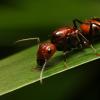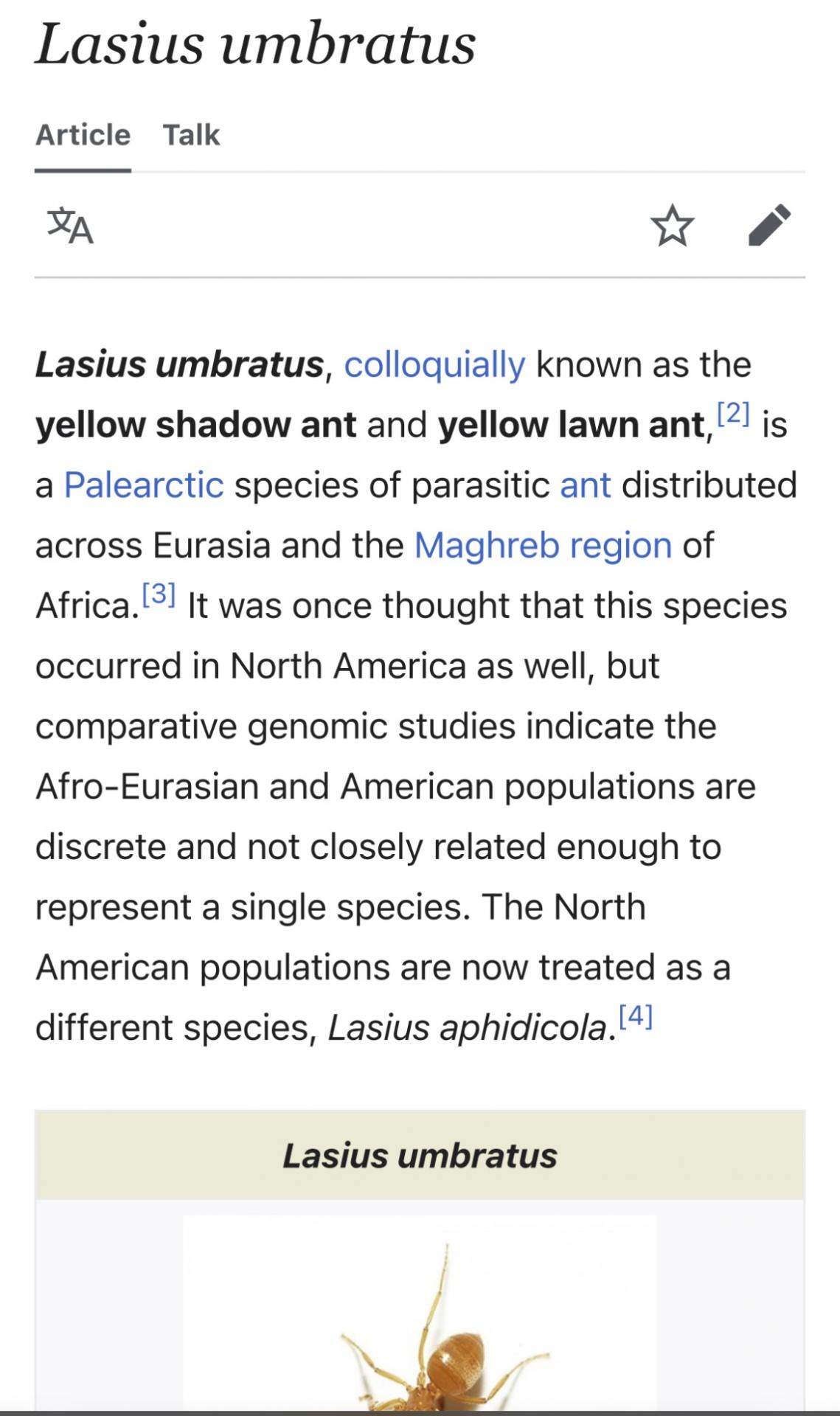- Formiculture.com
- Forums
- Gallery
- Members
- Member Map
- Chat

3 queens to ID
Started By
gsparrow
, Apr 20 2024 5:01 PM

Best Answer GOCAMPONOTUS , April 21 2024 - 11:44 AM
Genetics also play a part
Go to the full post 
26 replies to this topic
#21
 Offline
-
Posted April 21 2024 - 11:42 AM
Offline
-
Posted April 21 2024 - 11:42 AM
L. claviger are much more red. Most specimens (especially in the Eastern coast of the US) are typically red to dark red in color which the last ant pic lacks. They also have much skinnier abdomens (I have seen many queens in their nuptial flight season; all of which look exactly the same with barely any differences). A dark one would be rare in the eastern US but not impossible. Darker version are probably more common toward the west (all depends on the coloration of the ants that started before reproducing over and over again; and it also depends on environmental factors in those areas).
- GOCAMPONOTUS likes this
Keeping:
5x - S. molesta (founding) 2x - C. pennsylvanicus (colonies)
4x - C. chromaiodes (colonies)
4x - T. immigrans (founding queens and colonies)
1x - F. subsericea (founding)
Check out my C. nearcticus journal here: https://www.formicul...cticus-journal/
Check out my C. chromaiodes journal here: https://www.formicul...aiodes-journal/
#22
 Offline
-
Posted April 21 2024 - 11:44 AM
Best Answer
Offline
-
Posted April 21 2024 - 11:44 AM
Best Answer
Genetics also play a part
- Artisan_Ants likes this
Currently keeping: 2 C.vicinus colonies.2 C.sansabeanus. 1 C.leavissimus. 2 C.Ca02. 1 V.pergandei. 4 T.immigrans.1 F.pacifica. 1 C.hyatti
1 M.ergatognya
Trying to get my hands on :C.modoc,A.vercicolor, and Any Honeypots
#23
 Offline
-
Posted April 21 2024 - 6:01 PM
Offline
-
Posted April 21 2024 - 6:01 PM
Those specimens are probably L. aphidcola as well since they are quite similar. If they are dubious, it means they are likely mistakes.On AntMaps it says that L. umbratus are dubious/in error which still means that specimens were found in that region or state. Of course this could have have changed depending on when the map was last updated but that doesn’t mean that L. umbratus aren’t in the listed states at all. Florida as a matter of fact is one of the places where they are dubious/in error.There are no L. umbratus in America. She could be L. aphidcola, however. If she was lighter I’d be sure, however there are plenty of dark aphidcola.First one is S. invicta quite clearly (first all; the head is smaller than the thorax and second is the fact that the last petiole is smaller whereas S. geminata, the last petiole is longer. This varies from ant to ant though). The second is likely C. neararcticus due to long and skinny abdomen and small compared to scale. The last one is indeed a temporary parasite of Lasius. Most likely L. aphidicola as L. umbratus fly in September. Of course they go through hibernation but it is very very hard to ID from both species. Research show that L. aphidicola are just North American versions of L. umbratus but then why are they considered a different species in the US? There must the some differences. Other than that; this might be L. umbratus and it probably is due to the darker appearance in such light but I’m leaning towards L. aphidicola.
To add, none of the “Lasius umbratus” who exist in North America are genetically close enough to be considered the same species as European Lasius umbratus, instead comprising of Lasius aphidcola. Therefore, any populations of Lasius umbratus that somehow exist in North America have to be an invasive, introduced population from Europe (which as far as I know does not exist.)
Edited by The_Gaming-gate, April 22 2024 - 3:12 AM.
- GOCAMPONOTUS likes this
Ants are small creatures... but together... they can rule the world.
#24
 Offline
-
Posted April 22 2024 - 3:46 AM
Offline
-
Posted April 22 2024 - 3:46 AM
Oh well it looks like I didn’t read so carefully did I? Well then L. aphidicola it is then.
- The_Gaming-gate likes this
Keeping:
5x - S. molesta (founding) 2x - C. pennsylvanicus (colonies)
4x - C. chromaiodes (colonies)
4x - T. immigrans (founding queens and colonies)
1x - F. subsericea (founding)
Check out my C. nearcticus journal here: https://www.formicul...cticus-journal/
Check out my C. chromaiodes journal here: https://www.formicul...aiodes-journal/
#25
 Offline
-
Posted April 22 2024 - 1:29 PM
Offline
-
Posted April 22 2024 - 1:29 PM
Moral of the story for all is to do research before jumping to any conclusions. If you're uncertain on species, it's best to leave the ID at genus or subgenus rather than attempting to make guesses.
1. Solenopsis invicta
2. Camponotus sp.
3. Lasius umbratus-group (likely aphidicola)
- Artisan_Ants and GOCAMPONOTUS like this
"Float like a butterfly sting like a bee, his eyes can't hit what the eyes can't see."
- Muhammad Ali
Check out my shop and Formica journal! Discord user is bmb1bee if you'd like to chat.
Also check out my YouTube channel: @bmb1bee
#26
 Offline
-
Posted April 23 2024 - 3:44 AM
Offline
-
Posted April 23 2024 - 3:44 AM
1. Solenopsis invicta
2. Camponotus, almost certainly nearcticus
3. Lasius aphidicola
2. Camponotus, almost certainly nearcticus
3. Lasius aphidicola
Largely correct, though the color variation is a bit more complicated than just an east/west divide. Along a stretch of the east coast from southern PA & NJ through NC, there's a higher concentration of what Wing calls "variant" claviger, which, among some other differences, are generally lighter in color. If you go up to the northern east coast, there are more dark claviger, not just in the west. The divide between typical and variant claviger is far from a hard line, many if not most specimens will have some mixture of variant and typical traits, but the concentration of variant traits is just much higher in this region.L. claviger are much more red. Most specimens (especially in the Eastern coast of the US) are typically red to dark red in color which the last ant pic lacks. They also have much skinnier abdomens (I have seen many queens in their nuptial flight season; all of which look exactly the same with barely any differences). A dark one would be rare in the eastern US but not impossible. Darker version are probably more common toward the west (all depends on the coloration of the ants that started before reproducing over and over again; and it also depends on environmental factors in those areas).
Edited by Mettcollsuss, April 23 2024 - 3:45 AM.
- AnthonyP163, bmb1bee, Artisan_Ants and 1 other like this
#27
 Offline
-
Posted April 23 2024 - 11:43 AM
Offline
-
Posted April 23 2024 - 11:43 AM
This Lasius queen is really stirring up trouble.
Ants are small creatures... but together... they can rule the world.
1 user(s) are reading this topic
0 members, 1 guests, 0 anonymous users


















